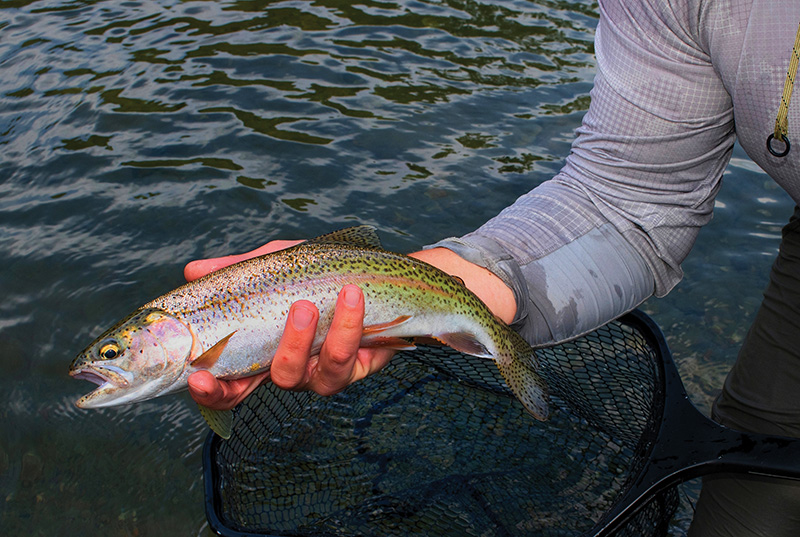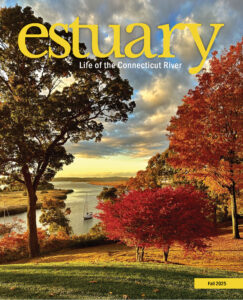 This article appears in the Fall 2025 issue
This article appears in the Fall 2025 issue
 Vermont’s White River
Vermont’s White River
Story and Photos by Ed Mitchell
On a late spring day, I sat in a rustic cabin in northern Vermont, guest of Owen Ward, head Orvis guide for the well-known Woodstock Inn. Owen is an energetic young man, fully vested in life outdoors. Along with his Orvis credential, he is also a licensed New Hampshire fishing guide, holds a degree in environmental studies from Kenyon College in Ohio, and works with Trout Unlimited on strategic wood additions stream habitat improvements while co-chairing the local chapter’s conservation committee. Besides fishing, Owen is also an avid hunter of both wild turkey and deer—and runs his own maple syrup operation in the winter.
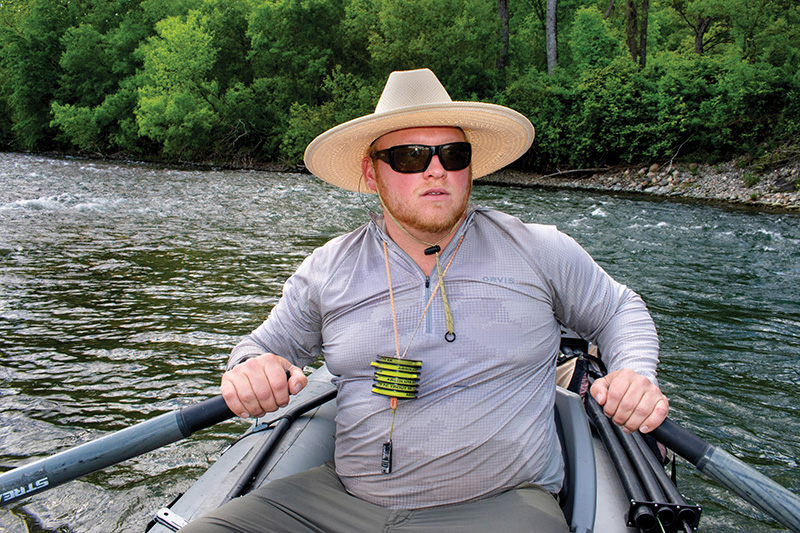
Guide Owen Ward navigates the White River.
Over a home-cooked dinner of venison medallions and wild-foraged mushrooms, we discussed the next day’s fishing on the White River, a trip delayed two long weeks by high water, something that has, in recent years, become increasingly common. While the cause of this repeat flooding may have multiple factors, climate change is at the top of the list. But the upper reaches of the White’s main stem were down to a flow rate of 1,750 CFS (cubic feet per second). Finally, conditions were right. In the morning, we planned to launch Owen’s whitewater raft in Stockbridge, Vermont, and float downstream, fishing our way toward the town of Bethel.
Originating on the slopes of Battell Mountain, near the crest of the Green Mountains, the White is a long, free-flowing river with a watershed of over 700 square miles. During its sixty-mile downstream odyssey, the main stem is joined by five major tributaries: the First Branch, Second Branch, Third Branch, West Branch, and the Tweed River, in addition to untold smaller creeks. Together these streams unite with the White’s main stem, one after the other, moving south and east, to greet the Connecticut River in White River Junction.
Around 9 a.m., we pushed off. Owen handed me a 5-weight fly rod and then grabbed the oars. On the end of a nine-foot leader rode a size 10# girdle bug on a jig hook, and above that, on a dropper, a tiny bead-headed mayfly nymph. Interestingly enough this is the identical rig I used with guide Chris Jackson on the Deerfield River back in the Spring issue of this magazine. The strategy is to offer trout a choice of a large fly or a small one—a ribeye or an hors d’oeuvre.
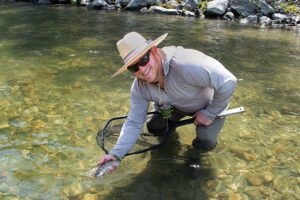
Stocked rainbows made up the morning’s catch.
In the early hours of the float, we caught and released small stocked rainbow trout, happy to have the action. Some fish preferred the big fly; some favored the small one. Still, our hope was to find the wild native trout the White is known for. Brook, brown, and rainbows all spawn in the White’s tributaries, their presence well documented by Vermont’s Fish and Wildlife Division. Thankfully, populations seem reasonably stable, despite the recent flooding. Drawn by cooler water, the brook trout enjoy the far, upper White River, while browns are more frequent in the lower reaches. Of the three, however, the rainbows have been the most successful, now considered a self-sustaining population that is growing in size and range. Like most rainbow, these trout are born wanderers. After spawning in the tributaries in the spring, they undertake a lengthy trek down to the Connecticut River. The following spring they return upriver to their native tributaries once again. It is a round-trip journey of over 100 miles.
As our float continues, I’m increasingly drawn to the river—each bend, riffle, and run holding a mystery. Both banks host dense forests, green trees reaching for a sapphire sky. While 1,300 feet above us, the Green Mountains peer down, silent sentinels that have for countless eons held the river to course. It is vistas like these that forever beckon anglers to rivers, offering a sense of times past, a sense of things lost, a sense of paradise.
Along a shady bank near the mouth of Locust Creek, a small tributary of the White, I get a solid strike. Clearly this is a larger fish. Instantly it skyrockets three feet above the river, causing Owen to yell, “Wild rainbow! Let him run!” Yards of fly line disappear, as my old Hardy Princess reel protests loudly. By now Owen has dropped the anchor and jumped ship, armed with the net. Three more times the rainbow leaps, each jump followed by a run. The tug-of-war see-saws for several long minutes, before the rainbow begins to tire, circling back toward us. As it nears the raft, however, it finds renewed strength, battling back into the current. Soon though, things go our way, and Owen puts the rainbow securely in the net. It had fought well out of proportion to its size, making it clear why the White’s wild migratory rainbows can be rightfully be called “steelhead.”
Owen brings my catch over, just long enough to allow me to take a quick closeup photograph. Unlike the pale, stocked rainbows we encountered in the morning, this creature is magnificent, as vibrant as a watercolor. Along its lateral line runs the species signature pink stripe; while its flanks are mint green, elaborately spotted with black dots that also coat its dorsal, adipose, and tail fins. Its belly and gill plate shine like polished silver, tinged with iridescence; its jet-black pupil surrounded by an iris of gold.
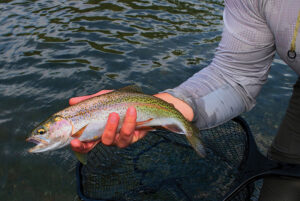
A beautiful wild native rainbow trout.
We return the fish to the current, shake hands, and celebrate. Sweet success. Back onboard, Owen hauls the anchor as I cast the team of nymphs back to the river. A minute later, however, I hook a second wild rainbow. Again Owen releases the anchor and scrambles overboard, net in hand. This rainbow is smaller yet fights with the same determined spirit, multiple jumps, multiple runs. Eventually it lands in the net, is photographed and sent on its way.
With hours and miles under our belt, we are fast approaching the takeout point. The trip nears its end. It gives me pause to look back over this day—the things I saw, the fish I released, all supplying rich memories to be savored down the road. And above all, I am sincerely grateful for my guide’s willingness to show me this Vermont river, to experience firsthand the mighty White.
Ed Mitchell is the author of four books on fly-fishing and has written for many magazines. He has over fifty years of experience in both fresh and saltwater fly-fishing. A special thanks to Joshua Morse, Public Information Officer for Vermont Fish and Wildlife, for getting this article off the ground, The Woodstock Inn for making guide Owen Ward available, and Fisheries Biologist Bret Ladago for information about White River’s wild trout.
Resources
Orvis Guide Owen Ward
At the Woodstock Inn’s Fly Shop,
802-457-5530, fish@woodstockinn.com
Follow Owen on Instagram @freestone_fanatic
Accommodations
The Woodstock Inn and Resort
Woodstock, Vermont
Fine accommodations and full-service fly shop
800-448-7900, www.woodstockinn.com

